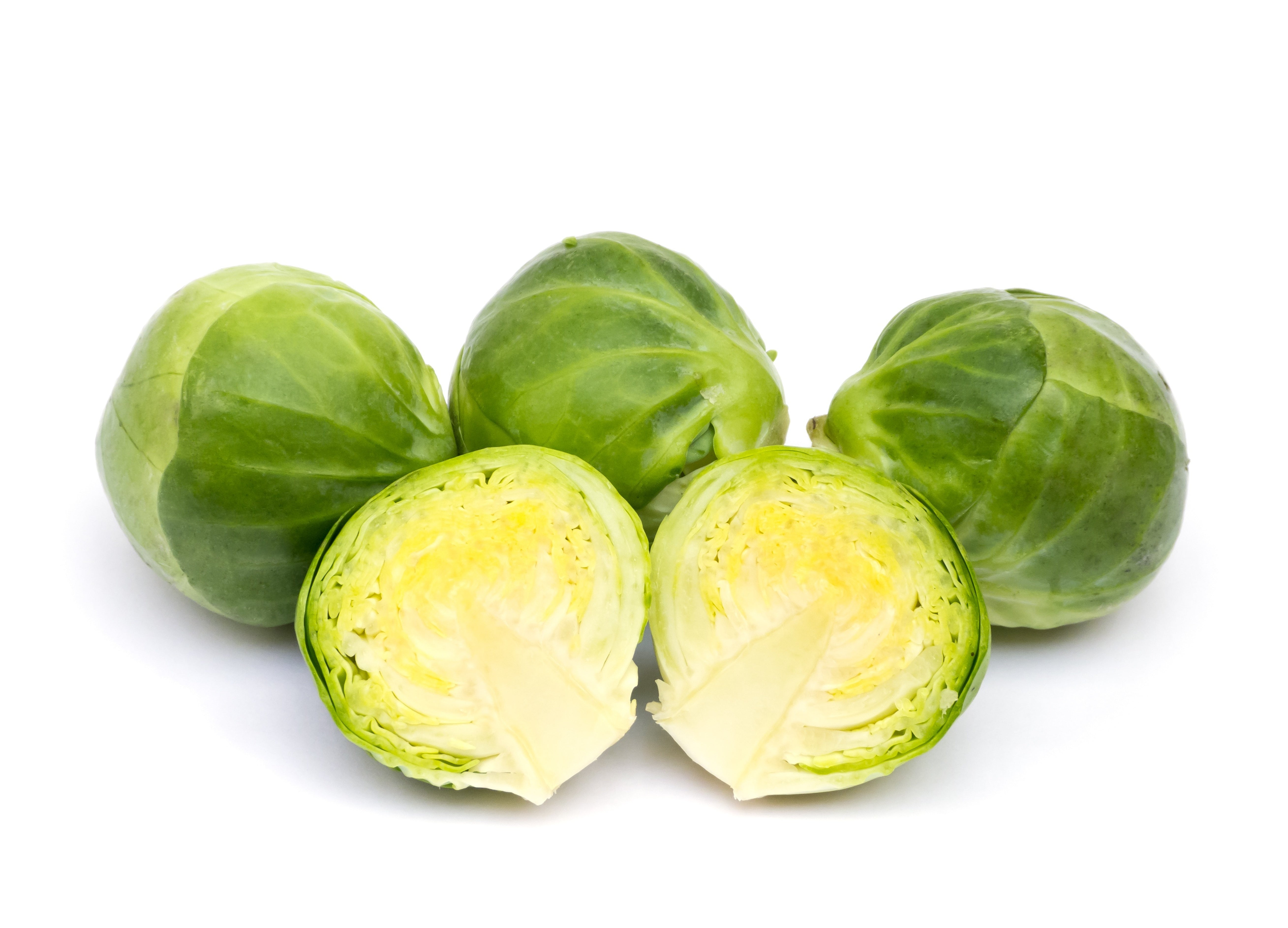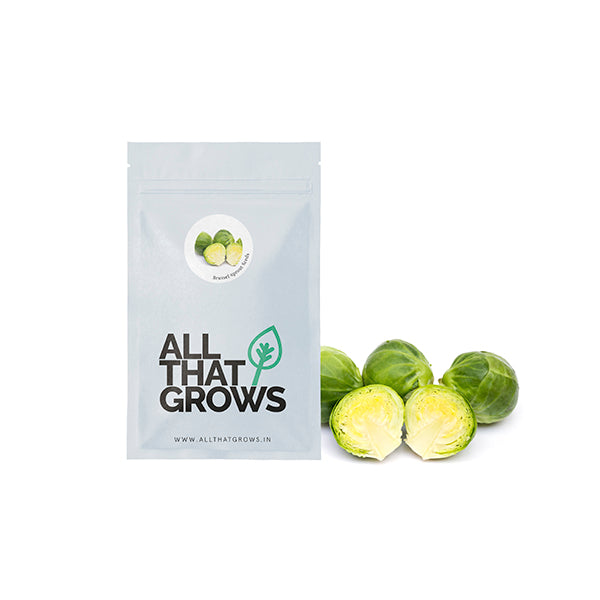



- SOWING
TIMEAugust - October
- Sowing
DistanceLine to Line - 5 to 6 inches
- Fruit
WeightN/A
- Fruit
ShapeSpherical crown of tightly packed leaves
- Days to
maturity130 to 150 days
- Details
- How to sow
- Reviews
Bussel sprouts, or Brassica oleracea, are from the Brassicaceae family of cabbages. No points for guessing that popular Brussel Sprout hail from Belgium, cultivated near Brussels. Hence the name. However, there are early records of this vegetable being cultivated and used in Afganistan & Iran as well. It is a cold hardy cabbage plant that thrives in winters. The leaves of Bussel Sprouts are tightly bound into a spherically shaped head and can be consumed cooked or raw. The taste of Brussel Sprouts is slightly nutty and earthy in flavor and is also a great source of proteins and vitamins. Researchers have also recently found that the detoxifying properties of Brussel Sprouts have the ability to fight cancer & other diseases to some extent. Adding them to your diet will enhance the body’s natural immune system promotes healthy cell formation. Since the plant of Brussel Sprouts takes very small space in the garden, it is a popular vegetable amongst a lot of home gardeners across the globe.
Planting instructions
Sow Brussel Sprouts in seed beds or containers at a depth of ½ to 1 inch. You can also sow the seeds indoors and transplant when the young plants are 4 to 6 inches long.
Brussel Spouts can be grown in any type of garden soil with adequate watering frequency. Brussel Sprouts is a sturdy plant and can tolerate winters as well if looked after well.
Since all members of the Brassicaceae family have a water content in their leaves so remember to keep the plants hydrated.
Brussel Sprouts are susceptible to boron deficiency which can cause the plants to develop hollow stems and smaller fruit.
Growing Requirements
Crop Rotation
Crop rotation after every year is also recommended for Brussel Sprouts since the soil may be depleted of essential nutrients after one crop.
Pests & Diseases
Clubroot is one the most common diseases with Brussel Sprout plant where roots of the plant may become swollen. In such cases, apply some lime to the roots and change the soil. Birds, caterpillar, and cabbage root fly are the main hindrances to the growth of the plant.
soil
Brussel Sprouts can be grown in any type of garden soil with a good level of moisture. Once the plants have grown 3 - 4 inches, water moderately and keep the top layer of the seeded pot moist. Brussels sprouts grow best in moist, fertile, well-draining soil with a slightly acidic pH between 6.0 and 6.5.
Spot
Choose a sunny spot for Brussel Sprouts which receives sunlight for at least 5 to 6 hours a day. Also, protect the plant against strong winds.
temperature
The ideal temperature of at temperatures between 7 and 24°C (45–75°F), with optimum growth occurring at 15–18°C (59–64°F) best for cultivating Brussel sprouts.
watering
Water moderately keeping the top layer of container/pot moist with good drainage.
how to harvest
Brussel sprouts will get mature & ready for harvest in about 120 to 150 days. Brussel sprout heads will be firm and green with 1 to 2-inch diameter.
Remove the heads which are starting to turn slightly yellow at the bottom first. The flavor of the sprouts also increases once the last frost has passed.

The productiveness of any seed we sell is subject to your local climatic conditions*, the sowing method you adopt, and your commitment to the planting process. We give no warranty, expressed or implied, and are in no way responsible for the produce.
Please note that all our seasonal recommendations/ sowing information is as per the local climatic conditions. *For more information on the optimum conditions required for growing seeds in your region, please contact us at, hello@allthatgrows.in or Whatsapp us at, +91 8544865077
Questions & Answers
Have a Question?
Be the first to ask a question about this.




Brussel Sprouts Seeds
Seed Type: Non-hybrid, Open Pollinated & Non-GMO
Head Shape: Miniature cabbage-like head with a cluster of tight leaves
Color: Green
Uses: Roasted Or Pan Fried In Butter With Various Herbs
Bussel sprouts, or Brassica oleracea, are from the Brassicaceae family of cabbages. No points for guessing that popular Brussel Sprout hail from Belgium, cultivated near Brussels. Hence the name. However, there are early records of this vegetable being cultivated and used in Afganistan & Iran as well. It is a cold hardy cabbage plant that thrives in winters. The leaves of Bussel Sprouts are tightly bound into a spherically shaped head and can be consumed cooked or raw. The taste of Brussel Sprouts is slightly nutty and earthy in flavor and is also a great source of proteins and vitamins. Researchers have also recently found that the detoxifying properties of Brussel Sprouts have the ability to fight cancer & other diseases to some extent. Adding them to your diet will enhance the body’s natural immune system promotes healthy cell formation. Since the plant of Brussel Sprouts takes very small space in the garden, it is a popular vegetable amongst a lot of home gardeners across the globe.
Seed Type: Non-hybrid, Open Pollinated & Non-GMO
Head Shape: Miniature cabbage-like head with a cluster of tight leaves
Color: Green
Uses: Roasted Or Pan Fried In Butter With Various Herbs
- SOWING
TIMEAugust - October
- Sowing
DistanceLine to Line - 5 to 6 inches
- Fruit
WeightN/A
- Fruit
ShapeSpherical crown of tightly packed leaves
- Days to
maturity130 to 150 days
Planting instructions
Sow Brussel Sprouts in seed beds or containers at a depth of ½ to 1 inch. You can also sow the seeds indoors and transplant when the young plants are 4 to 6 inches long.
Brussel Spouts can be grown in any type of garden soil with adequate watering frequency. Brussel Sprouts is a sturdy plant and can tolerate winters as well if looked after well.
Since all members of the Brassicaceae family have a water content in their leaves so remember to keep the plants hydrated.
Brussel Sprouts are susceptible to boron deficiency which can cause the plants to develop hollow stems and smaller fruit.
Growing Requirements
Crop Rotation
Crop rotation after every year is also recommended for Brussel Sprouts since the soil may be depleted of essential nutrients after one crop.
Pests & Diseases
Clubroot is one the most common diseases with Brussel Sprout plant where roots of the plant may become swollen. In such cases, apply some lime to the roots and change the soil. Birds, caterpillar, and cabbage root fly are the main hindrances to the growth of the plant.
soil
Brussel Sprouts can be grown in any type of garden soil with a good level of moisture. Once the plants have grown 3 - 4 inches, water moderately and keep the top layer of the seeded pot moist. Brussels sprouts grow best in moist, fertile, well-draining soil with a slightly acidic pH between 6.0 and 6.5.
Spot
Choose a sunny spot for Brussel Sprouts which receives sunlight for at least 5 to 6 hours a day. Also, protect the plant against strong winds.
temperature
The ideal temperature of at temperatures between 7 and 24°C (45–75°F), with optimum growth occurring at 15–18°C (59–64°F) best for cultivating Brussel sprouts.
watering
Water moderately keeping the top layer of container/pot moist with good drainage.
how to harvest
Brussel sprouts will get mature & ready for harvest in about 120 to 150 days. Brussel sprout heads will be firm and green with 1 to 2-inch diameter.
Remove the heads which are starting to turn slightly yellow at the bottom first. The flavor of the sprouts also increases once the last frost has passed.



 Sign In
Sign In








